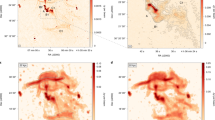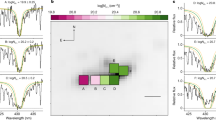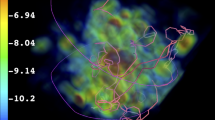Abstract
Models and simulations1,2,3,4 of the epoch of reionization predict that spectra of the 21-centimetre transition of atomic hydrogen will show a clear fluctuation peak, at a redshift and scale, respectively, that mark the central stage of reionization and the characteristic size of ionized bubbles. This is based on the assumption5,6,7 that the cosmic gas was heated by stellar remnants—particularly X-ray binaries—to temperatures well above the cosmic microwave background at that time (about 30 kelvin). Here we show instead that the hard spectra (that is, spectra with more high-energy photons than low-energy photons) of X-ray binaries8,9 make such heating ineffective, resulting in a delayed and spatially uniform heating that modifies the 21-centimetre signature of reionization. Rather than looking for a simple rise and fall of the large-scale fluctuations (peaking at several millikelvin), we must expect a more complex signal also featuring a distinct minimum (at less than a millikelvin) that marks the rise of the cosmic mean gas temperature above the microwave background. Observing this signal, possibly with radio telescopes in operation today, will demonstrate the presence of a cosmic background of hard X-rays at that early time.
This is a preview of subscription content, access via your institution
Access options
Subscribe to this journal
Receive 51 print issues and online access
$199.00 per year
only $3.90 per issue
Buy this article
- Purchase on Springer Link
- Instant access to full article PDF
Prices may be subject to local taxes which are calculated during checkout



Similar content being viewed by others
References
Barkana, R. & Loeb, A. Unusually large fluctuations in the statistics of galaxy formation at high redshift. Astrophys. J. 609, 474–481 (2004)
Furlanetto, S. R., Zaldarriaga, M. & Hernquist, L. The growth of H II regions during reionization. Astrophys. J. 613, 1–15 (2004)
Mellema, G., Iliev, I. T., Pen, U.-L. & Shapiro, P. R. Simulating cosmic reionization at large scales—II. The 21-cm emission features and statistical signals. Mon. Not. R. Astron. Soc. 372, 679–692 (2006)
Zahn, O. et al. Simulations and analytic calculations of bubble growth during hydrogen reionization. Astrophys. J. 654, 12–26 (2007)
Madau, P., Meiksin, A. & Rees, M. J. 21 centimeter tomography of the intergalactic medium at high redshift. Astrophys. J. 475, 429–444 (1997)
Furlanetto, S. R. The global 21-centimeter background from high redshifts. Mon. Not. R. Astron. Soc. 371, 867–878 (2006)
Furlanetto, S. R., Oh, S. P. & Briggs, F. H. Cosmology at low frequencies: the 21 cm transition and the high-redshift Universe. Phys. Rep. 433, 181–301 (2006)
Fragos, T. et al. X-ray binary evolution across cosmic time. Astrophys. J. 764, 41 (2013)
Fragos, T. et al. Energy feedback from X-ray binaries in the early Universe. Astrophys. J. 776, L31 (2013)
Pritchard, J. R. & Furlanetto, S. 21-cm fluctuations from inhomogeneous X-ray heating before reionization. Mon. Not. R. Astron. Soc. 376, 1680–1694 (2007)
Christian, P. & Loeb, A. Measuring the X-ray background in the reionization era with first generation 21 cm experiments. J. Cosmol. Astroparticle Phys. 09, 014 (2013)
Mesinger, A., Furlanetto, S. & Cen, R. 21CMFAST: a fast, seminumerical simulation of the high-redshift 21-cm signal. Mon. Not. R. Astron. Soc. 411, 955–972 (2011)
Mesinger, A., Ferrara, A. & Spiegel, D. S. Signatures of X-rays in the early Universe. Mon. Not. R. Astron. Soc. 431, 621–637 (2013)
Bennett, C. L. et al. Nine-year Wilkinson Microwave Anisotropy Probe (WMAP) observations: final maps and results. Astrophys. J. 208 (suppl.). 20 (2013)
Planck Collaboration Planck 2013 results. XVI. Cosmological parameters. Preprint at http://arxiv.org/abs/1303.5076 (2013)
Schroeder, J., Mesinger, A. & Haiman, Z. Evidence of Gunn-Peterson damping wings in high-z quasar spectra: strengthening the case for incomplete reionization at z ∼ 6−7. Mon. Not. R. Astron. Soc. 428, 3058–3071 (2013)
Haiman, Z., Rees, M. J. & Loeb, A. Destruction of molecular hydrogen during cosmological reionization. Astrophys. J. 476, 458–463 (1997); erratum Astrophys. J. 484, 985 (1997)
Ahn, K. et al. Detecting the rise and fall of the first stars by their impact on cosmic reionization. Astrophys. J. 756, L16 (2012)
Fialkov, A., Barkana, R., Visbal, E., Tseliakhovich, D. & Hirata, C. M. The 21-cm signature of the first stars during the Lyman-Werner feedback era. Mon. Not. R. Astron. Soc. 432, 2909–2916 (2013)
Dekel, A. & Silk, J. The origin of dwarf galaxies, cold dark matter, and biased galaxy formation. Astrophys. J. 303, 39–55 (1986)
Wyithe, J. S. B. & Loeb, A. A suppressed contribution of low-mass galaxies to reionization due to supernova feedback. Mon. Not. R. Astron. Soc. 428, 2741–2754 (2013)
Visbal, E., Barkana, R., Fialkov, A., Tseliakhovich, D. & Hirata, C. M. The signature of the first stars in atomic hydrogen at redshift 20. Nature 487, 70 (2012)
McQuinn, M., Zahn, O., Zaldarriaga, M., Hernquist, L. & Furlanetto, S. R. Cosmological parameter estimation using 21 cm radiation from the epoch of reionization. Astrophys. J. 653, 815–834 (2006)
Parsons, A. R. et al. New limits on 21cm EoR from PAPER-32 consistent with an X-ray heated IGM at z = 7.7. Preprint at http://arxiv.org/abs/1304.4991 (2013)
Barkana, R. & Loeb, A. Detecting the earliest galaxies through two new sources of 21 centimeter fluctuations. Astrophys. J. 626, 1–11 (2005)
Fialkov, A., Barkana, R., Pinhas, A. & Visbal, E. Complete history of the observable 21-cm signal from the first stars during the pre-reionization era. Mon. Not. R. Astron. Soc. 437, L36–L40 (2014)
McClintock, J. E. & Remillard, R. A. in Compact Stellar X-Ray Sources (eds Lewin, W. & van der Klis, M. ) 157–213 (Cambridge Astrophys. Ser. 157, Cambridge Univ. Press, 2006)
Tamura, M. et al. The truncated disk from Suzaku data of GX 339–4 in the extreme very high state. Astrophys. J. 753, 65 (2012)
Naoz, S., Noter, S. & Barkana, R. The first stars in the Universe. Mon. Not. R. Astron. Soc. 373, L98–L102 (2006)
Fialkov, A., Barkana, R., Tseliakhovich, D. & Hirata, C. Impact of the relative motion between dark matter and baryons on the first stars: semi-analytical modelling. Mon. Not. R. Astron. Soc. 424, 1335–1345 (2012)
Barkana, R. & Loeb, A. In the beginning: the first sources of light and the reionization of the Universe. Phys. Rep. 349, 125–238 (2001)
Tseliakhovich, D. & Hirata, C. Relative velocity of dark matter and baryonic fluids and the formation of the first structures. Phys. Rev. D 82, 083520 (2010)
Furlanetto, S. R. & Stoever, S. J. Secondary ionization and heating by fast electrons. Mon. Not. R. Astron. Soc. 404, 1869 (2010)
Verner, D. A., Ferland, G. J., Korista, K. T. & Yakovlev, D. G. Atomic data for astrophysics. II. New analytic FITS for photoionization cross sections of atoms and ions. Astrophys. J. 465, 487 (1996)
Hirata, C. M. Wouthuysen-Field coupling strength and application to high-redshift 21-cm radiation. Mon. Not. R. Astron. Soc. 367, 259–274 (2006)
Chuzhoy, L. & Shapiro, P. R. Ultraviolet pumping of hyperfine transitions in the light elements, with application to 21 cm hydrogen and 92 cm deuterium lines from the early Universe. Astrophys. J. 651, 1 (2006)
Wyithe, J. S. B. & Loeb, A. A characteristic size of ∼10 Mpc for the ionized bubbles at the end of cosmic reionization. Nature 432, 194 (2004)
Safranek-Shrader, C., Milosavljevic, M. & Bromm, V. Star formation in the first galaxies—II: Clustered star formation and the influence of metal line cooling. Preprint at http://arxiv.org/abs/1307.1982 (2013)
Wise, J. H., Abel, T., Turk, M. J., Norman, M. L. & Smith, B. D. The birth of a galaxy—II. The role of radiation pressure. Mon. Not. R. Astron. Soc. 427, 311–326 (2012)
Mirabel, I. F., Dijkstra, M., Laurent, P., Loeb, A. & Pritchard, J. R. Stellar black holes at the dawn of the universe. Astron. Astrophys. 528, A149 (2011)
Basu-Zych, A. R. et al. The X-ray star formation story as told by Lyman break galaxies in the 4 Ms CDF-S. Astrophys. J. 762, 45 (2013)
Basu-Zych, A. R. et al. Evidence for elevated X-ray emission in local Lyman break galaxy analogs. Astrophys. J. 774, 152 (2013)
Gilfanov, M., Grimm, H.-J. & Sunyaev, R. L X -SFR relation in star-forming galaxies. Mon. Not. R. Astron. Soc. 347, L57 (2004)
Mineo, S., Gilfanov, M. & Sunyaev, R. X-ray emission from star-forming galaxies—II. Hot interstellar medium. Mon. Not. R. Astron. Soc. 426, 1870–1883 (2012)
Oh, S. P. Reionization by hard photons. I. X-rays from the first star clusters. Astrophys. J. 553, 499 (2001)
Vasudevan, R. V., Mushotzky, R. F. & Gandhi, P. Can we reproduce the X-ray background spectral shape using local active galactic nuclei? Astrophys. J. 770, L37 (2013)
Lützgendorf, N. et al. M•−σ relation for intermediate mass black holes in globular clusters. Astron. Astrophys. 555, A26 (2013)
Tanaka, T., Perna, R. & Haiman, Z. X-ray emission from high-redshift miniquasars: self-regulating the population of massive black holes through global warming. Mon. Not. R. Astron. Soc. 425, 2974–2987 (2012)
Ciardi, B., Salvaterra, R. & Di Matteo, T. Lyα versus X-ray heating in the high-z intergalactic medium. Mon. Not. R. Astron. Soc. 401, 2635–2640 (2010)
Wyithe, J. S. B. & Loeb, A. Self-regulated growth of supermassive black holes in galaxies as the origin of the optical and X-ray luminosity functions of quasars. Astrophys. J. 595, 614 (2003)
Sazonov, S., Yu, Ostriker, J. P. & Sunyaev, R. A. Quasars: the characteristic spectrum and the induced radiative heating. Mon. Not. R. Astron. Soc. 347, 144–156 (2004)
Volonteri, M. & Gnedin, N. Y. Relative role of stars and quasars in cosmic reionization. Astrophys. J. 703, 2113–2117 (2009)
McConnell, N. J. & Ma, C.-P. Revisiting the scaling relations of black hole masses and host galaxy properties. Astrophys. J. 764, 184 (2013)
Shakura, N. I. & Sunyaev, R. A. Black holes in binary systems. Observational appearance. Astron. Astrophys. 24, 337–355 (1973)
Chen, X. & Miralda-Escudé, J. The spin-kinetic temperature coupling and the heating rate due to Lyα scattering before reionization: predictions for 21 centimeter emission and absorption. Astrophys. J. 602, 1–11 (2004)
Chuzhoy, L. & Shapiro, P. R. Heating and cooling of the early intergalactic medium by resonance photons. Astrophys. J. 655, 843–846 (2007)
Furlanetto, S. R. & Loeb, A. Large-scale structure shocks at low and high redshifts. Astrophys. J. 611, 642–654 (2004)
Acknowledgements
We are grateful to S. Naoz for drawing our attention to the work of T. Fragos, who provided us with detailed model spectra of X-ray binaries, which helped motivate this study. This work was supported by Israel Science Foundation grant number 823/09, and by the LabEx ENS-ICFP (grant numbers ANR-10-LABX-0010 and ANR-10-IDEX-0001-02 PSL*).
Author information
Authors and Affiliations
Contributions
R.B. initiated the project. A.F. developed and ran the simulations and made the figures by substantially extending a code that was originally developed by E.V. working with R.B. The text was written by R.B. and edited by the other authors.
Corresponding authors
Ethics declarations
Competing interests
The authors declare no competing financial interests.
Extended data figures and tables
Extended Data Figure 1 The 21-cm power spectrum versus redshift.
We show the same data as in Fig. 3 (with the same nomenclature), but as a function of 1 + z, where z is the redshift, a direct observable (given that the observed wavelength is 21(1 + z) cm). This presentation has the advantage of clearly separating out the early and late reionization cases, while showing that reionization does not affect the redshift of the new minimum (solid curves) at k = 0.5 Mpc−1. Indeed, this minimum marks the cosmic heating transition (to within 2% in redshift in all our model calculations), while the minimum at k = 0.1 Mpc−1 is typically delayed owing to the evolving power spectrum shape (see Extended Data Fig. 2). We consider wavenumbers k = 0.1 Mpc−1 (a and b) and k = 0.5 Mpc−1 (c and d), for each of our two cases for galactic halos, atomic cooling (a and c) or massive halos (b and d). The results shown (here and in Fig. 3) correspond to a total of four different reionization histories. Late reionization with atomic cooling reaches 1/4, 1/2, 3/4 and full reionization at z = 10.7, 8.7, 7.7 and 7.0; the corresponding redshifts for early reionization are 11.8, 10.0, 9.1 and 8.4. Massive halos give a sharper reionization transition, with late reionization advancing through z = 10.3, 8.9, 8.3 and 7.7, while early reionization corresponds to z = 11.4, 10.2, 9.7 and 9.0.
Extended Data Figure 2 Full 21-cm power spectra.
We show examples of full power spectra corresponding to the data shown in Fig. 3 and Extended Data Fig. 1, for the cases with fX = 1 and late reionization. We compare the new XRB spectrum9 (solid curves) to the previously adopted soft spectrum (dashed curves), and show the saturated heating case for reference (dotted curves). We consider atomic cooling (a) or massive halos (b). In order of increasing cosmic age, we consider three key moments (which fall at different redshifts for the various cases, based on Extended Data Fig. 1): the minimum fluctuation at k = 0.5 Mpc−1 (blue curves), the minimum at k = 0.1 Mpc−1 (green curves), and the midpoint of reionization (red curves). For the new spectrum, strong evolution is predicted in the power spectrum shape, because large-scale fluctuations from X-ray heating dominate (up to k ≈ 0.5 Mpc−1) at the heating transition (blue solid curves) but then rapidly decline so that density fluctuations come to dominate (at k > 0.1 Mpc−1 at the time shown in green solid curves), with an eventual large-scale boost by the ionized bubbles (red solid curves).
Rights and permissions
About this article
Cite this article
Fialkov, A., Barkana, R. & Visbal, E. The observable signature of late heating of the Universe during cosmic reionization. Nature 506, 197–199 (2014). https://doi.org/10.1038/nature12999
Received:
Accepted:
Published:
Issue Date:
DOI: https://doi.org/10.1038/nature12999
This article is cited by
-
PRATUSH experiment concept and design overview
Experimental Astronomy (2023)
-
Astrophysical constraints from the SARAS 3 non-detection of the cosmic dawn sky-averaged 21-cm signal
Nature Astronomy (2022)
-
On the detection of a cosmic dawn signal in the radio background
Nature Astronomy (2022)
-
The REACH radiometer for detecting the 21-cm hydrogen signal from redshift z ≈ 7.5–28
Nature Astronomy (2022)
-
An X-ray detection of star formation in a highly magnified giant arc
Nature Astronomy (2019)
Comments
By submitting a comment you agree to abide by our Terms and Community Guidelines. If you find something abusive or that does not comply with our terms or guidelines please flag it as inappropriate.



